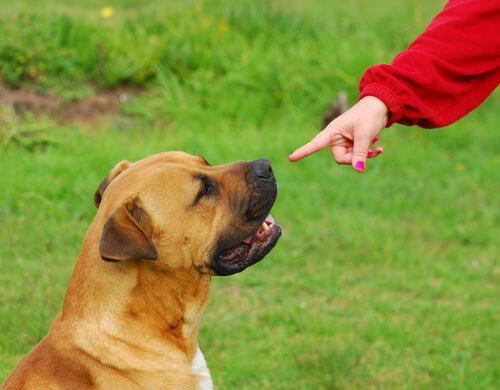How to Diagnose Deafness in Dogs


Written and verified by the lawyer Francisco María García
Does your dog not respond when you call? Is your dog not obeying commands? Probably your dog is having trouble hearing you because deafness is normal in many dogs. Therefore, it’s a good idea to be aware of some of the symptoms of deafness in dogs.
This condition can be either genetic or caused by infection or injury. Age is also an important factor. As dogs get older, they may gradually start losing their hearing.
Behavior to Look Out For
Most of the time, people don’t notice that their dog has hearing problems. Unless they completely lose their hearing, it can be difficult to notice when your dog is having troubles hearing. A good way to find out that your dog is having hearing problems is by testing his attention at home.
Try to Get Your Dog’s Attention by Running This Test
When your dog is not looking at you, try to make some sort of noise. Try to get his attention by only allowing his sense of hearing to detect you, i.e. nothing that causes air movement or vibrations. Jingle your keys or turn up the volume of the radio or television. If your dog doesn’t react then you should be concerned.
You could also wait until your dog is asleep and begin calling him in a quiet voice, gradually getting louder. He will eventually react to you if he is area semi-deaf. If he doesn’t respond at all, then most likely he is deaf.

If a dog has lost his hearing in just one ear, he may get confused because he can’t locate the source of the sound very well. In any case, if you suspect that your dog is losing his hearing, then you should go straight to the vet.
Techniques Used to Diagnose Deafness in Dogs
At home, you can try a couple of things to confirm your suspicions. However, a vet will have the right tools to effectively diagnose dog. To do this, vets generally use a BAER test, brainstem auditory evoked response test, where they evaluate the dog’s brain activity in response to a series of sounds.
The test consists of connecting electrodes to the head and the base of the ears. They then apply sound stimuli in the form of clicks and measure the cerebral response.
They also use methods like tympanometry, which assesses the function of the eardrum and the middle ear. Likewise, they could use an acoustic reflex test which measures the ears’ ability to respond loud sounds.
Otoacoustic emissions tests are another way of diagnosing deafness in dogs. It consists of stimulating the hair cells in the ear and evaluating the response.
Using these methods, it’s possible to find out the extent of your dog’s deafness, whether he has suffered total a loss of hearing, or just in one ear, or only a certain amount of hearing.
Symptoms of Deafness in Dogs
There are a few signs which can be useful if you suspect that your dog is having difficulty hearing:
- Your dog doesn’t wake up to loud noises.
- He no longer responds to noises as he did in the past.
- He doesn’t come when you call him by name or he stops obeying commands. These are signs that something isn’t right with your dog’s hearing.
Deafness in Puppies
There are also certain behaviors to watch out for with puppies to indicate deafness. A puppy which strongly bites other dogs could not be hearing well and may not realize the pain that they’re causing. If they don’t wake up when their mother or brothers and sisters move, this could also be a sign of deafness.

You want to make it absolutely clear that a deaf dog, whether partially or totally deaf, is still a completely normal pet. You shouldn’t worry about it. Your dog will still be happy, playful, affectionate, and loyal.
If you’re thinking about adopting a deaf puppy, he won’t be any different to other puppies. He just won’t be able to hear you. One final point: you shouldn’t pay too much attention either to myths or rumors that deaf dogs can be grumpy or aggressive.
Does your dog not respond when you call? Is your dog not obeying commands? Probably your dog is having trouble hearing you because deafness is normal in many dogs. Therefore, it’s a good idea to be aware of some of the symptoms of deafness in dogs.
This condition can be either genetic or caused by infection or injury. Age is also an important factor. As dogs get older, they may gradually start losing their hearing.
Behavior to Look Out For
Most of the time, people don’t notice that their dog has hearing problems. Unless they completely lose their hearing, it can be difficult to notice when your dog is having troubles hearing. A good way to find out that your dog is having hearing problems is by testing his attention at home.
Try to Get Your Dog’s Attention by Running This Test
When your dog is not looking at you, try to make some sort of noise. Try to get his attention by only allowing his sense of hearing to detect you, i.e. nothing that causes air movement or vibrations. Jingle your keys or turn up the volume of the radio or television. If your dog doesn’t react then you should be concerned.
You could also wait until your dog is asleep and begin calling him in a quiet voice, gradually getting louder. He will eventually react to you if he is area semi-deaf. If he doesn’t respond at all, then most likely he is deaf.

If a dog has lost his hearing in just one ear, he may get confused because he can’t locate the source of the sound very well. In any case, if you suspect that your dog is losing his hearing, then you should go straight to the vet.
Techniques Used to Diagnose Deafness in Dogs
At home, you can try a couple of things to confirm your suspicions. However, a vet will have the right tools to effectively diagnose dog. To do this, vets generally use a BAER test, brainstem auditory evoked response test, where they evaluate the dog’s brain activity in response to a series of sounds.
The test consists of connecting electrodes to the head and the base of the ears. They then apply sound stimuli in the form of clicks and measure the cerebral response.
They also use methods like tympanometry, which assesses the function of the eardrum and the middle ear. Likewise, they could use an acoustic reflex test which measures the ears’ ability to respond loud sounds.
Otoacoustic emissions tests are another way of diagnosing deafness in dogs. It consists of stimulating the hair cells in the ear and evaluating the response.
Using these methods, it’s possible to find out the extent of your dog’s deafness, whether he has suffered total a loss of hearing, or just in one ear, or only a certain amount of hearing.
Symptoms of Deafness in Dogs
There are a few signs which can be useful if you suspect that your dog is having difficulty hearing:
- Your dog doesn’t wake up to loud noises.
- He no longer responds to noises as he did in the past.
- He doesn’t come when you call him by name or he stops obeying commands. These are signs that something isn’t right with your dog’s hearing.
Deafness in Puppies
There are also certain behaviors to watch out for with puppies to indicate deafness. A puppy which strongly bites other dogs could not be hearing well and may not realize the pain that they’re causing. If they don’t wake up when their mother or brothers and sisters move, this could also be a sign of deafness.

You want to make it absolutely clear that a deaf dog, whether partially or totally deaf, is still a completely normal pet. You shouldn’t worry about it. Your dog will still be happy, playful, affectionate, and loyal.
If you’re thinking about adopting a deaf puppy, he won’t be any different to other puppies. He just won’t be able to hear you. One final point: you shouldn’t pay too much attention either to myths or rumors that deaf dogs can be grumpy or aggressive.
This text is provided for informational purposes only and does not replace consultation with a professional. If in doubt, consult your specialist.








